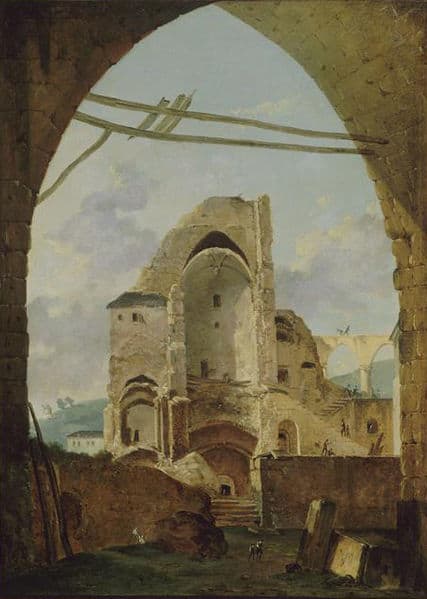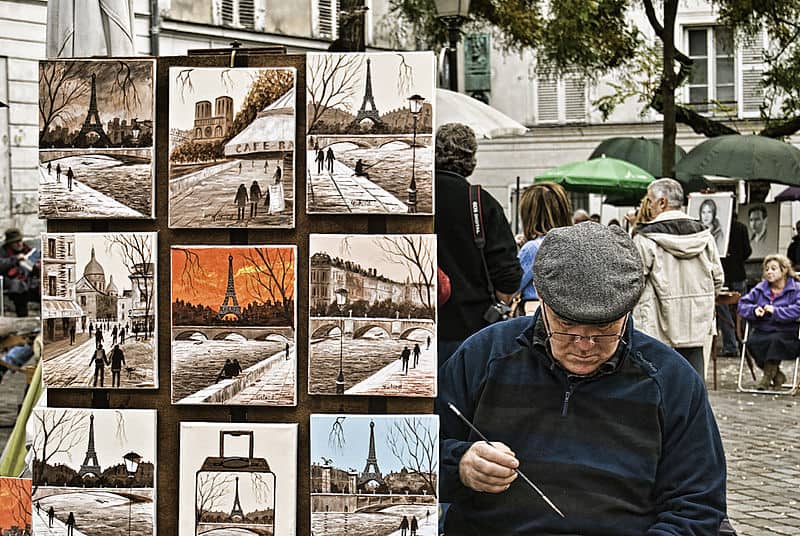Top 10 Facts About Place du Tertre Before the French Revolution
Walking through the Place du Tertre in Montmartre today, you’ll find it hard to image the square void of the 150 artists who sit and create works here day after day .
This square on the hill has a long standing history within the city of Paris. The 18th century buildings that surround it can easily lead one to assume it was constructed around the same time.
The Place du Tertre was actually here long before all of the other buildings in Montmartre. The neighborhood was somewhat constructed around it and prior to the Revolution, it served a very different role in the community.
1. It was Established by King Louis VI in 1133
The year 1133 is a time none of us can even begin to imagine what life on the planet must have been like, let alone in Montmartre.
Much of Europe back then was ruled by religion. In 1133, King Louis VI commissioned the construction of the Montmartre Abbey; a prestigious residency that would house members of the clergy.
The square that would one day become the Place du Tertre was constructed alongside the Abbey as an architectural addition

Montmartre Abbey – by Franzy89 – Wikimedia Commons
2. The Montmartre Abbey Thrived for Centuries
The Montmartre Abbey became a well known point of religious presence atop the Montmartre hill in what is now the 18th arrondissement. A stark contrast in a village that would someday represent the artist’s hub of the city of Paris.
Many people are astounded to learn that the Sacre Coeur Church’s construction was only completed in 1914. Most assume it was part of Montmartre since back in the Abbey days.
It’s presence on top of the hill in the now absence of the Abbey is an apt one. A reminder of how this village began before any artists even thought to wander in.

Montmartre Abbey in 1626 – by Franzy89 – Wikimedia Commons
3. The Place du Tertre was a Recreational Ground for the Abbey Residents
Even the monks and religious folk dwelling in the Montmartre Abbey needed an outdoor area in which to relax from time to time.
That is what the Place du Tertre square gave the Abbey members. It was a space where gatherings, prayer and meetings could take place in the Parisian outdoors. There is speculation that townsfolk were invited to the square from time to time though this is difficult to prove.
4. The Land Surrounding the Place du Tertre was Completely Barren
Today Montmartre is so built up and suburban that free guided walking tours can merely make their way between the winding streets to get from one side of the hill to to other.
Before the Revolution, much of Montmartre hillside was nothing but barren land. One that you could roam through without need for roads.
The Abbey and the Place du Tertre remained virtually untouched by surrounding development for many centuries.

Montmartre Abbey and the barren surroundings – by Unknown – Wikimedia Commons
5. It was Opened to the Public in 1635 and Named Montmartre Village Central Square
As the years went by, Montmartre expanded and became a sought after residential area for people in Paris. A decision was made in 1635 that the square no longer be solely reserved for the Abbey.
It was renamed Montmartre Village Central Square and opened to the public. For the first time in history the people of Montmartre could come and go in the square as they pleased.
6. At this Time Much Development was Occurring Around the Square
The opening of a public square only furthered the appeal of moving to the village of Montmartre. This called for more development and infrastructure to find its was onto the hill as well.
Land started to become scarce; everyone wanted a piece of this up and coming part of town. Buildings began to pop up all over the village and would eventually enclose the public square all together.
This is why the “modern” buildings around the square would never suggest to an onlooker that it had been there since 1133.

Construction of the Saint-Pierre Church next to the Abbey in Montmartre – by Jacques Auguste Régnier – Wikimedia Commons
7. Still No Artists in Sight at the Place du Tertre
In spite of the village appeal and the new developments happening year after year, there was still no sign of distinct artist culture in Montmartre prior to the Revolution.
In fact, it was more of an industrial neighborhood with multiple windmills cultivating the land and producing grain.
There are two main windmills collectively known as the Le Moulin de la Galette near the summit of Montmartre that can still be visited today. They are no longer in use; one is on private property and can be viewed from the street and the other features a cafe also named Le Moulin de la Galette.

Development on Montmartre hill – by Unknown – Wikimedia Commons
8. The Montmartre Abbey was Destroyed in 1794
In 1794, as turmoil swept though Paris, the Montmartre Abbey became one of the many landmarks in the city to be destroyed in the Revolution.
Thankfully, public squares are harder to eradicate and the Montmartre Village Central Square was left out of the destruction.

Destruction of Montmartre Abbey – by Louis-Gabriel Moreau – Wikimedia Commons
9. The Place du Tertre Got Its Name
As the French began to rebuilt their society, many changes took place amongst the different arrondissements.
Montmartre Village Central Square was renamed the Place du Tertre which literally translated to the square on the hill. It would serve the public as it had been prior to the Revolution.

Place du Tertre in the 20th Century – by Unknown – Wikimedia Commons
10. After the Revolution, Artists Make Their Way Into the Square
It is at this time, after the Revolution, that artists began flocking into Paris in attempt to live in the Bohemian culture that was sweeping through Europe. Montmartre was cheap, somewhat central and quite beautiful — the ideal place for poor creatives to set up homes.
It is then that the Place du Tertre began its longstanding journey with the artists of Paris; Everyone from Picasso to Dali was spotted in this square at one point or another.
The rest, as they say, is history and the Place du Tertre lives on as the official artist’s square of Paris. Have you been for a visit yet?

Place du Tertre – by palm z – Wikimedia Commons
Planning a trip to Paris ? Get ready !
These are Amazon’s best-selling travel products that you may need for coming to Paris.
Bookstore
- The best travel book : Rick Steves – Paris 2023 – Learn more here
- Fodor’s Paris 2024 – Learn more here
Travel Gear
- Venture Pal Lightweight Backpack – Learn more here
- Samsonite Winfield 2 28″ Luggage – Learn more here
- Swig Savvy’s Stainless Steel Insulated Water Bottle – Learn more here
Check Amazon’s best-seller list for the most popular travel accessories. We sometimes read this list just to find out what new travel products people are buying.














